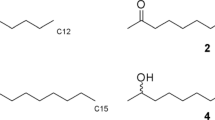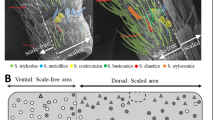Abstract
In most moth species the female sex pheromone evaporates from the surface of a gland that is everted and exposed to the air1–3. Considerable attention has been directed towards the pheromone biology of arctiid moths because (1) the female pheromone gland is atypical, consisting of a branched tube or pair of tubes that is invaginated into the haemocoel and opens dorsally between the eight and ninth abdominal segments4–5, and (2) pheromone release behaviour ('calling') is also atypical, involving rhythmic protrusion and retraction of the abdominal tip4. This pulsing action, which alternately exposes and occludes the orifice of the pheromone gland, is thought to result in the expulsion of discrete puffs of pheromone in the vapour phase4. We now report that calling females of the arctiid species, Pyrrharctia isabella, emit a visible stream of liquid droplets. This emission consists solely of the sex pheromone, with no incidental material or inert carrier material present in the aerosol. The quantities of pheromone released in this way are the largest known for a female moth. Also this is the first report of an airborne sex-attractant released as a liquid.
This is a preview of subscription content, access via your institution
Access options
Subscribe to this journal
Receive 51 print issues and online access
$199.00 per year
only $3.90 per issue
Buy this article
- Purchase on Springer Link
- Instant access to full article PDF
Prices may be subject to local taxes which are calculated during checkout
Similar content being viewed by others
References
Percy, J. & Weatherston, J. in Pheromones (ed. Birch, M. C.) 11–34 (North-Holland, Amsterdam, 1974).
Elkinton, J. S. & Cardé, R. T. in Chemical Ecology of Insects (eds Bell, W. J. & Cardé, R. T.) 73–91 (Chapman and Hall, London, 1984).
Tamaki, Y. in Comprehensive Insect Physiology, Biochemistry, and Pharmacology (eds Kerkut, G. A. & Gilbert, L. I.) 145–191 (Pergamon, Oxford, 1985).
Conner, W. E. et al. Behav. Ecol. Sociobiol. 7, 55–63 (1980).
Meyer, W. L. thesis, Cornell Univ. (1984).
Leonhardt, B. A., Neal, J. W. Jr, Klun, J. A., Schwarz, M. & Plimmer, J. R. Science 219, 314–316 (1983).
Boppré, M. in The Biology of Butterflies (eds Vane-Wright, R. I. & Ackery, P. R.) 259–275 (Academic, London, 1984).
Roelofs, W. L. & Cardé, R. T. Science 171, 684–686 (1971).
Schal, C. & Cardé, R. T. Experientia 41, 1617–1619 (1985).
Bjostad, L. B., Gaston, L. K. & Shorey, H. H. J. Insect Physiol. 26, 493–498 (1980).
Greenfield, M. D. & Coffelt, J. A. Behaviour 84, 287–315 (1983).
Bjostad, L. B., Wolf, W. A. & Roelofs, W. L. Insect Biochem. 11, 73–79 (1981).
Green, H. L. & Lane, W. R. Particulate Clouds: Dust, Smokes and Mists (Spon, London, 1964).
Krasnoff, S. B. thesis, Cornell Univ. (1987).
Schal, C., Charlton, R. C. & Cardé, R. T. J. chem. Ecol. 13, 1115–1130 (1987).
Bossert, W. H. & Wilson, E. O. J. theor. Biol. 5, 443–469 (1963).
Mankin, R. W., Vick, K. W., Mayer, M. S., Coffelt, J. A. & Callahan, P. S. J. chem. Ecol. 6, 929–950 (1980).
Roelofs, W. L. J. chem. Ecol. 4, 685–699 (1978).
Conner, W. E. thesis, Cornel Univ. (1979).
Werner, R. A. Ann. Ent. Soc. Am. 70, 264–266 (1977).
Hollander, A. L., Yin, C. & Schwalbe, C. P. J. insect. Physiol. 28, 513–518 (1982).
Preining, O. in Aerosol Science (ed. Davies, C. N.) 111–136 (Academic, London, 1966).
Author information
Authors and Affiliations
Rights and permissions
About this article
Cite this article
Krasnoff, S., Roelofs, W. Sex pheromone released as an aerosol by the moth Pyrrharctia isabella. Nature 333, 263–265 (1988). https://doi.org/10.1038/333263a0
Received:
Accepted:
Issue Date:
DOI: https://doi.org/10.1038/333263a0
This article is cited by
-
Aerosol Alteration of Behavioral Response to Pheromone in Bombyx mori
Journal of Chemical Ecology (2023)
-
Calling behavior of the female german cockroach,Blattella germanica (Dictyoptera: Blattellidae)
Journal of Insect Behavior (1993)
-
100 years of pheromone research
Naturwissenschaften (1992)
-
(R,Z)-5-(?)-(oct-1-enyl)oxacyclopentan-2-one, the sex pheromone of the scarab beetleAnomala cuprea
Naturwissenschaften (1991)
-
Interpopulational variation in emitted pheromone blend of cabbage looper moth,Trichoplusia ni
Journal of Chemical Ecology (1990)
Comments
By submitting a comment you agree to abide by our Terms and Community Guidelines. If you find something abusive or that does not comply with our terms or guidelines please flag it as inappropriate.



